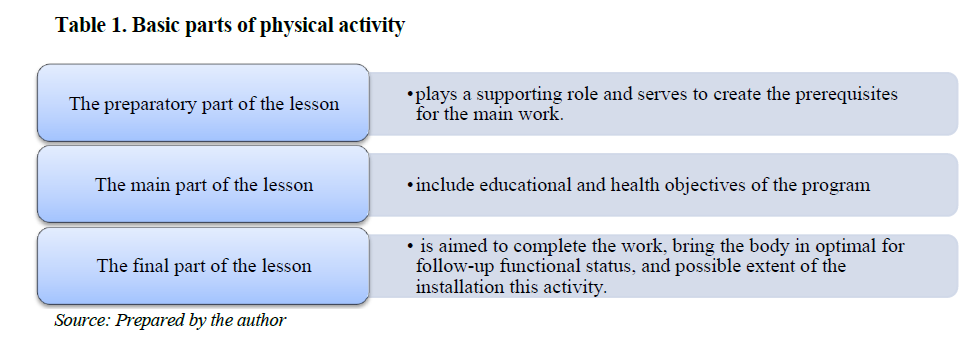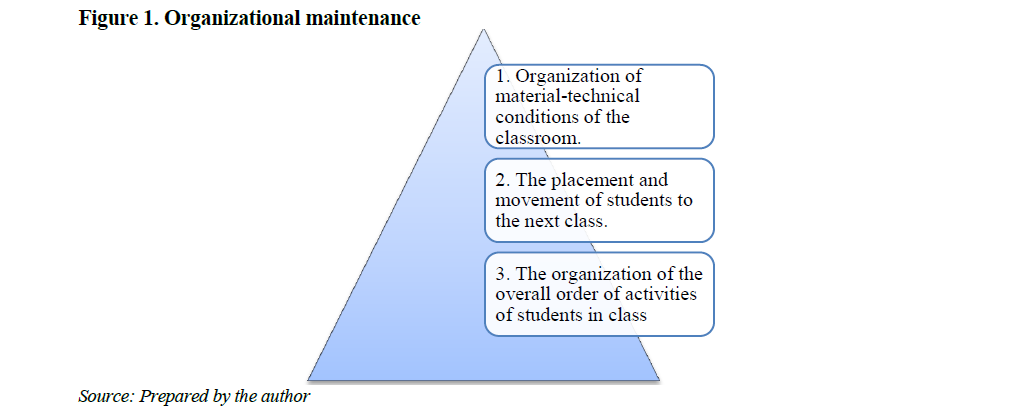This article is devoted to the development of the concept of the formation of physical culture and physical education of students in secondary schools and students. This article presents a didactically effective periodization of physical exercises in working areas of three levels of sports pedagogy of cooperation, as well as the testing technique in four modes of assessment of motor activity (speed-strength, power endurance, fitness level and athletic form) of students in schools and universities in the process of their training. In addition, in this paper, the general regularities of the constant of harmonic development of personality in the system of physical education are revealed. The received data supplement the forms and means of sports pedagogical communication and cooperation, the provisions of scientific theories of physical education and personality education, encourage to active activity, given that these characteristics play an important role in self-improvement and motivation of pupils and students of universities.
Achievement of the solution of the physical education tasks is possible only with creating interests of children in different forms, which affects the pedagogical and good health effect. Different lessons have a few common features. That is why the same form can be presented in different ways in a variety of classifications [1-4]. The basic principles of the organization of physical education are the following: the qualitative and quantitative teaching of the pedagogical guides, which define the system of theoretical and pedagogical tasks; bounded structure and limit timeframes; the analysis of the conclusions; systematic verification of stable scheduling; relatively stable systematization of students by age and preparedness level. The first objective of the physical education is aimed to health and educational tasks.
The content of lessons mirrors to the unity of three basic elements. These elements represent the following characteristic components. Included in lessons physical exercises. This is a general item of content, one side of a larger, substantial subset.
The content of the activity associated with the implementation of the proposed exercises. This aspect of the content consists of very diverse intellectual and physical actions of students, which include listening the teacher, observation, implementation, etc. Results depends directly from the activities of children.
The content of teacher's activity, which consists of the following steps: setting and clarifying objectives, defining specific tasks and the organization of their implementation, continuous monitoring of actions of the students, the analysis of these actions, evaluation of performance, adjusting workloads, and direction of the conduct involved, relationships, etc.
Physical activity is divided into three parts: preparatory, main and final (see Table 1). They are mandatory and are always located in the sequence listed. The selection of these parts is conditioned by certain physiological and pedagogical regularities. It provides strictly gradual inclusion of functional systems of the body engaged in core activities, also maintenance and effective use of achieved efficiency for the entire time of homework and finally the optimal alignment of the state of the body of child and the psychological setup for the next training [5-8].
The tasks of the preparatory segment: a) primary organization of students, familiarization with the upcoming work and creation the required psychological installation; b) the gradual functional training of the student to high loads; the creation of a favorable emotional state.
In the preparatory part of the lesson using a variety of physical exercises techniques, which are already well mastered by the students. Most often it is different exercises, some gymnastic exercises of general preparatory character, different ways of walking, running and continuous rhythmic jumps performed from gradually increasing, but relatively moderate load.
The tasks of the main part of the lesson are: a) harmonic and special development of the musculoskeletal, cardiovascular and respiratory systems, the establishment and maintenance of correct posture, the hardening of the body; b) students have the necessary knowledge in the field of motor activity, improvement of the system of motor abilities and skills; с) development of motor skills; g) raising the moral, intellectual and volitional qualities. In the main part of the study any exercises that serve as effective solution of these problems may be applied.
Table 1. Basic parts of physical activity
Source: Prepared by the author Source: Prepared by the author
The most characteristic tasks of the final part of the session are: a) reducing the excitation of the cardiovascular, respiratory and nervous systems, excessive tension of separate groups of muscles; b) the regulation of emotional state; с) summarizing the lessons, a brief analysis, if necessary, certain aspects of the behavior of students. The most typical exercises for final part of the session: different options of walking and other natural movements aimed to the gradual reduction of the tension of function of the cardiovascular and respiratory systems; relaxation exercises and the formation of posture; special exercises for attention.
The timing and specific content of the reviewed parts of the lessons are variable, because it depends on features and condition of work, the objectives, the specifics of selected exercises, the total duration, external conditions and other factors. The three-part division of the classes defines a common structure, highlighting the large mandatory part. This is only the first level of structural organization of classes. Features that are more substantial include determination of the sequence of exercises in each part and provision of optimal relations between them. This is the second level of building classes.
The third level of the structure of the classes, except organization of educational actions of the teacher and children are also different support actions related to the organization of the work of subgroups, preparation equipment, distribution of educational equipment, etc. Organizational maintenance are described in Figure 1.
Figure 1. Organizational maintenance
Placement and movement are creating the optimum conditions of work, providing students with the opportunity to see the teacher or each other and have sufficient space for proper exercise; for the teacher – ability to observe students, engage them in the necessary contacts. The organization of a general order of learning activities realized in a various organizational and methodological forms.
The first group includes those forms in which all students are working simultaneously. Depending on what job they perform, there are frontal, group and individual forms of organization. Front organization of the activities is characterized by the simultaneous fulfillment of all the students the same task regardless of the location and of the selected forms of construction (in columns, in a circle, a few lines). Often it is used to control the homogeneous activity of the student, for example in learning exercises that do not require insurance and assistance. Group organization of activities provides simultaneous execution of students various tasks in several groups. The division of students into groups and determination of the content of the tasks is carried out taking into account gender, level of preparedness and etc. Individual organization activities provides simultaneous execution of students independently of other personal tasks determined by the teacher level of fitness, motor abilities. This form represents the implementation of a differentiated approach to the training and education of students and can be used for different purposes: to align the proficiency of the students of the group; to facilitate the formation of skills of independent work and the development of creativity.
The second group forms of organization of student activities in the lesson are those in which students carry out exercise alternately (one doing the exercise, others observe, analyze, help). Depending on sequence, it is distinguished between "mutual" form of organization, in-line, shift and alternate in pairs. "Mutual" form of organization provides for alternate students work in small groups, each of which sequentially performs a series of tasks on specially prepared areas typically located within a circle of the room. The composition of the exercises is chosen by the effects on different muscular groups for the development of various physical abilities. This form is almost never used in the training exercise because of the more complicated control and management of the actions of the student, timely assistance and insurance. The dosage is determined individually for each student, based on its maximum possibilities. In addition, the load can be controlled by varying the number of places to exercise (the more the number of places, the smaller the number of students in each group, and hence a shorter duration of pauses between exercises). Tray form involves the performance of students of the same exercise one after the other. This form is used in cases when exercises are mastered by the students. Shift form of training involves performing the same exercise within multiple groups (for example, one group performs an exercise on the gym wall and the other observes, evaluates). The number of repetitions of the exercise of each group depends on the bandwidth of the space class and the allotted time [9].
Alternate exercises in pairs provide a breakdown of all the students in pairs, which alternately performs one exercise and the other is assistance, evaluation and correction action. Then students switch roles. In some cases, forms of organization activities can be combined. For example, if you group inside of a group exercise can be either the front, or shift, or inline, or in pairs. The ability of the teacher to maintain discipline in class largely determines its effectiveness. At the same time maintaining discipline on the lesson is not a limit for student movements and the expression of emotions and the formation of their abilities to see, hear the teacher and quickly follow his instructions when necessary.
A wide variety of contingents of program, environments, training and many other factors meets not less variety of specific occupations. To successfully choose the most appropriate plan of the order of application of the exercise and distinguish the main contents and the structure of each lesson. The diversity of physical education classes is distributed to the subordination of the classification group of several interrelated features characterizing the focus and substantive content, as well as private educational tasks and methodological diversity of the studies.
References:
- Zheleznyak Yu.D., Petrov P.K. Osnovy metodicheskoy deyatelnosti v fizicheskoi culture I – Moscow: Publishing Center "Academy", 2013.
- Kainova B. Obshaya pedagogika fizicheskoi kultury i sporta/ EB Kainova. 2009.
- Soloviev G.M. Conceptualniy podhod v obespechenii kachestva obrazovaniya po fizicheskoi kulture // Pedagogical Education and – 2008. – No. 8.
- Krayevsky V.V., Khutorsky V. Osnovy obucheniya: Didactica i metodika. Textbook for students of higher educational institutions. – Moscow: Publishing Center "Academy", 2007.
- Leontiev A. Pedagogicheskoe obshenie. – M .: Knowledge, 1979.
- Leontiev N. Deyatelnost. Soznanie. Lichnost. – Moscow: Politizdat, 1979.
- Mnogokompleksnie snaryadi,prisposobleniya I technicheskie sredstva v fizicheskom voxpitanii. – Minsk,
- Soloveichik Teaching with enthusiasm. – M., 1971.
- Skatkin M.N. Sovershenstvovanie processa obucheniya. – , 1971.

